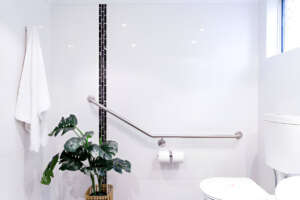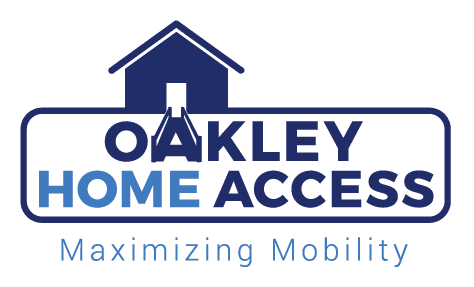How to Improve Bathroom and Home Lighting for Seniors
Everyone deserves to move confidently within their home, regardless of age. As eyesight changes and mobility challenges arise with age, lighting becomes increasingly important. Poorly lit spaces can conceal obstacles and cause falls, a leading cause of injury in seniors. At Oakley Home Access, we partner with Narragansett families to design and install lighting systems that support safe, independent living at any age.
Key Takeaways
- Proper lighting for seniors home safety significantly reduces fall risk, especially in stairways, hallways, and bathrooms.
- Layering ambient, task, and night lighting customizes visibility for different activities and times.
- Motion sensors, smart bulbs, and non-glare LEDs offer independence and comfort.
- Oakley Home Access provides tailored lighting assessments and installations as part of its broader safety services.
Why Lighting Matters for Senior Home Safety

With age, the eyes undergo significant changes: smaller pupils, slower adaptation from light to dark, increased glare sensitivity, and reduced contrast detection. These changes make obstacles harder to spot and transitions between lighting conditions riskier.
Studies show well-lit homes see substantial reductions in falls among seniors. In Narragansett, where historic homes often feature small windows and low ceilings, updating lighting can be one of the most effective fall-prevention measures.
How to Incorporate Lighting for Senior Safety in Bathroom Remodels
As we age, our needs change, and the design of essential spaces like the bathroom must adapt accordingly. One of the most critical considerations when remodeling a bathroom for seniors is proper lighting, as recommended by the National Institute on Aging. Good lighting in a bathroom can make the difference between a safe, accessible space and a potential hazard. From reducing the risk of slips and falls to making daily activities easier, incorporating the right lighting is key to creating a senior-friendly bathroom.
Optimal Lighting for Seniors in Bathrooms
When planning bathroom lighting for elderly individuals, you want to ensure the lighting is well placed. The best senior-friendly bathroom lighting solutions incorporate a mix of:
Ambient lighting
Provides general illumination throughout the bathroom. Use fixtures that offer even, bright lighting without creating harsh shadows. Ceiling-mounted fixtures, such as flush-mounted or recessed lights, are ideal for consistent light coverage.
Task lighting
Focuses on specific areas where seniors need extra visibility, such as the shower, vanity, and toilet areas. Installing focused lights, such as adjustable wall sconces or under-cabinet lighting, can help illuminate these key areas and make tasks like grooming and bathing easier and safer.
Accent lighting
Adds an extra layer of safety by illuminating features like grab bars, shelves, or steps. Small LED strip lights or puck lights can be placed along these areas to provide subtle illumination that enhances safety without being overwhelming.
Room-by-Room Guide to Safer Lighting for Seniors
1. Entryways and Hallways
These areas are frequently used and often overlooked. Poor lighting in hallways and entryways can result in missteps or stumbles, particularly at night. Installing ambient overhead lighting ensures that the space is always illuminated, while motion-sensor sconces provide additional safety without requiring seniors to fumble for light switches. Placing light switches at accessible heights and using rocker or dimmer switches can also greatly improve usability.
2. Bathrooms
Bathrooms are one of the most dangerous rooms for seniors due to wet surfaces and hard fixtures. Adequate lighting can help avoid accidents during nighttime bathroom visits. Task lighting around the mirror helps with grooming tasks such as shaving or applying makeup. Installing motion-activated lights near toilets and showers provides much-needed illumination without requiring manual operation. Diffused LED lights are particularly beneficial because they reduce glare on shiny surfaces like tile and porcelain.
3. Kitchens
Kitchens are another area that requires layered lighting. Under-cabinet LEDs provide direct light for meal preparation areas, improving visibility and reducing the risk of cutting or burning accidents. Daylight-balanced bulbs help reduce eye strain and provide better color rendering, which is essential for reading labels or checking food doneness. Enhancing lighting above the sink and stove further ensures a safe cooking environment.
4. Bedrooms
Bedrooms should offer both relaxation and functionality. Seniors benefit from bedside lamps that are easy to operate—touch-sensitive or voice-controlled options eliminate the need for reaching. Night lighting along the path to the bathroom is crucial for safe midnight navigation. Using warmer light tones helps promote restful sleep and avoids disrupting circadian rhythms.
5. Stairs and Living Areas
Stairs are particularly hazardous for seniors. Lighting each tread with LED strips or installing step-edge markers dramatically improves visibility. Even general lighting should eliminate dark corners that may hide tripping hazards. Remote or smart light switches ensure lighting can be activated without needing to physically navigate to a switch, improving both safety and convenience.
Lighting Features That Help Seniors Stay Safe
When considering lighting for seniors home safety, these features can make a significant difference:
- Motion Sensor Lights – These lights automatically activate when someone enters a room or hallway, significantly reducing the likelihood of falls that occur in the dark. Ideal for hallways, bathrooms, and entryways, they eliminate the need to locate switches in low light.
- Smart Bulbs – Smart bulbs can be adjusted for brightness and color temperature. They also support voice control or app control, giving seniors the ability to control lighting from a seated or lying position—great for those with limited mobility or dexterity.
- Non-Glare LED Bulbs – These bulbs offer a more comfortable viewing experience by minimizing sharp shadows and reflections. Consistent, balanced lighting is crucial for seniors with sensitive vision or eye conditions like cataracts or glaucoma.
- Nightlights with Sensors – These provide soft, low-level illumination in critical areas such as the bedroom, bathroom, and hallways. They automatically turn on in low-light conditions and are unobtrusive, offering guidance without interrupting sleep.
- Rocker or Touch-Activated Switches – Traditional toggle switches can be difficult for arthritic hands. Rocker switches or touch-activated options allow seniors to turn lights on and off more easily, reducing frustration and promoting independence.
- Step Markers and Pathway Lighting – LED markers or pathway lights installed along stair treads, baseboards, or exterior walkways help seniors safely navigate elevation changes and unfamiliar terrain, especially in the evening or during storms.
Each of these lighting options supports a safer, more accessible home—aligned with Oakley Home Access’s commitment to comfort, visibility, and independence for seniors aging in place.
Vision, Safety & Wellbeing: The Hidden Bonuses
Effective lighting does more than prevent falls, it enhances the overall quality of life. Seniors with better lighting often enjoy improved mental health and cognitive function, reduced feelings of isolation, and increased activity levels. Using blue-enriched daylight during the day helps stimulate alertness and maintain energy levels. In the evening, soft warm lights support melatonin production and restful sleep, promoting better circadian balance and emotional stability.
Related blog: Bathroom Safety Tips for Seniors
Conclusion
When you invest in lighting for seniors home safety, you’re investing in confidence, independence, and peace of mind. Well-lit homes empower seniors to live their days (and nights) safely.
Choose Brighter, Safer Living with Oakley Home Access
Oakley Home Access helps Narragansett families create homes that support safety and aging in place, one light fixture at a time. Our expert evaluations and smart lighting upgrades blend seamlessly with practical home modifications for a welcoming, accessible space.
Contact us today to schedule a free lighting and safety assessment.
Frequently Asked Questions
Why is proper lighting essential for senior safety?
Aging eyes need more light to see details and contrast. Well-lit spaces reduce falls by making obstacles clear and supporting independence.
What type of bulbs are best for seniors?
LEDs with color temperatures of 3000–5000K provide clarity and focus without harsh glare. Warm tones work well for bedrooms, while daylight bulbs support tasks.
Will nightlights really prevent trips?
Yes, motion-sensor nightlights guide movement without waking the brain fully. They’re proven to reduce mishaps at night.
